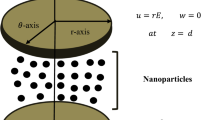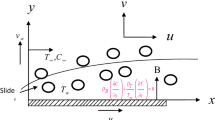Abstract
We consider a curved surface upon which the Casson micropolar nanofluid flow is discharged to understand the behavior of such flow and heat progression. The non-Newtonian fluid flow is controlled with the introduction of a magnetic force which is directed against the flow to alter the moment of flow. An increase in the numerical value of modified Hartmann number slows down the flow by adding discharge against the flow. Lorentz force produced by increasing the curve of the channel suppresses the flow velocity. The micropolar parameter reduces the drag and helps in increasing the fluid flow. Mathematical modeling of the problem is done by taking into account the conventional assumptions taken in fluid flow theories. The modeled equations are simplified by considering similar transformation variables used in the contemporary literature. Numerical result is obtained by using bvp4c solver used in MATLAB by allowing the acceptable tolerance level at 1e−4. Various tests are carried out to choose the best match of the parametric values which help in achieving the defined boundary conditions. The output of the various solutions is plotted under varying values of different parameters, and henceforth the changes occurred are noted and discussed. The behavior of velocity, microrotational, temperature and concentration profiles is observed by comparing the graphical and tabular values. The role of different physical quantities under different parametric assumptions for stretching/shrinking channel is also taken into account and highlighted.










Similar content being viewed by others
Abbreviations
- \(K(1)\) :
-
Micropolar parameter
- \(\varepsilon (1)\) :
-
Non-dimensional parameter
- \({\text{Re}}_{{\text{s}}} (1)\) :
-
Reynolds number
- \(n(1)\) :
-
Micro-gyration
- \(N\,\left( {{\text{m}}\;{\text{s}}^{{ - {1}}} } \right)\) :
-
Angular velocity components
- \(u, v\,\left( {\text{m}} \right)\) :
-
Velocity components
- \(K^{*} (1)\) :
-
Curvature parameter
- \(u\,\left( {{\text{m}}\;{\text{s}}^{ - 1} } \right)\) :
-
Velocity vector r-direction
- \(\beta (1)\) :
-
Casson fluid parameter
- \({\text{Sh}}_{{\text{s}}} \left( 1 \right)\) :
-
Sherwood number
- \(N_{{\text{T}}} \left( 1 \right)\) :
-
Thermophoresis parameter
- \(\lambda (1)\) :
-
Stretching parameter
- \(\gamma (1)\) :
-
Dimensionless parameter
- \(\alpha\, \left( {{\text{m}}^{2} \;{\text{s}}^{ - 1} } \right)\) :
-
Thermal diffusivity
- T (K):
-
Temperature
- \(T_{{\text{w}}} \,\left( {\text{K}} \right)\) :
-
Wall temperature
- \(T_{\infty }\, \left( {\text{K}} \right)\) :
-
Ambient temperature
- \(S\left( 1 \right)\) :
-
Suction/injection parameter
- \(M(1)\) :
-
Modified Hartmann number
- \(k\,\left( {{\text{Ns}}\;{\text{m}}^{ - 2} } \right)\) :
-
Vertex viscosity
- \(\left( {c_{{\text{p}}} } \right)_{{\text{f}}} \left( {{\text{J}}\;{\text{kg}}^{ - 1} \;{\text{K}}^{ - 1} } \right)\) :
-
Heat capacity of fluid
- \(s\,\left( {\text{m}} \right)\) :
-
Arc length
- \(N_{{\text{B}}}\) :
-
Brownian motion parameter
- \(\tau_{{{\text{rs}}}} ({\text{pa}})\) :
-
Wall shear stress
- \({\text{Ec}}(1)\) :
-
Eckert number
- \({\text{Re}}_{{\text{s}}} (1)\) :
-
Reynolds number
- \({\text{Le}}\) :
-
Lewis number
- \({\Pr}(1)\) :
-
Prandtl number
- \(R({\text{m}})\) :
-
Radius of curvature
- \(\rho \left( {{\text{kg}}\;{\text{m}}^{ - 3} } \right)\) :
-
Fluid density
- \(\nu \left( {{\text{m}}^{2} \;{\text{s}}^{ - 1} } \right)\) :
-
Viscosity of kinematic
- \(\tau (1)\) :
-
Ratio between heat capacity and base fluid
- \(\mu \left( {{\text{Ns}}\;{\text{m}}^{ - 2} } \right)\) :
-
Dynamic viscosity
References
Choi SU, Eastman JA. Enhancing thermal conductivity of fluids with nanoparticles (No. ANL/MSD/CP-84938; CONF-951135–29). Argonne National Lab., IL (United States). 1995.
Mekheimer KS, Salem AM, Zaher AZ. Peristaltically induced flow due to a surface acoustic wavy moving wall. Chin J Phys. 2013;51(5):968–82.
Akbar NS, Tripathi D, Khan ZH, Bég OA. A numerical study of magnetohydrodynamic transport of nanofluids over a vertical stretching sheet with exponential temperature-dependent viscosity and buoyancy effects. Chem Phys Lett. 2016;661:20–30.
Nayak MK, Akbar NS, Tripathi D, Pandey VS. Three dimensional MHD flow of nanofluid over an exponential porous stretching sheet with convective boundary conditions. Therm Sci Eng Progr. 2017;3:133–40.
Nayak MK, Akbar NS, Tripathi D, Khan ZH, Pandey VS. MHD 3D free convective flow of nanofluid over an exponentially stretching sheet with chemical reaction. Adv Powder Technol. 2017;28(9):2159–66.
Akbar NS, Tripathi D, Khan HZ. Numerical simulation of nanoparticles with variable viscosity over a stretching sheet. In: Rao SP, editor. Numerical simulations in engineering and science. IntechOpen; 2018. https://doi.org/10.5772/intechopen.71224.
Prakash J, Ansu AK, Tripathi D. Alterations in peristaltic pumping of Jeffery nanoliquids with electric and magnetic fields. Meccanica. 2018;53(15):3719–38.
Prakash J, Siva EP, Tripathi D, Bég OA. Thermal slip and radiative heat transfer effects on electro-osmotic magnetonanoliquid peristaltic propulsion through a microchannel. Heat Transf Asian Res. 2019;48(7):2882–908.
Nayak MK, Prakash J, Tripathi D, Pandey VS. 3D radiative convective flow of ZnO-SAE50nano-lubricant in presence of varying magnetic field and heterogeneous reactions. Propul Power Res. 2019;8(4):339–50.
Narla VK, Tripathi D, Bég OA. Analysis of entropy generation in biomimetic electroosmotic nanofluid pumping through a curved channel with joule dissipation. Therm Sci Eng Progr. 2020;15:100424.
Prakash J, Tripathi D, Bég OA. Comparative study of hybrid nanofluids in microchannel slip flow induced by electroosmosis and peristalsis. Appl Nanosci. 2020;10:1693–1706.
Acharya N, Mabood F. On the hydrothermal features of radiative Fe3O4–graphene hybrid nanofluid flow over a slippery bended surface with heat source/sink. J Therm Anal Calorim. 2020. https://doi.org/10.1007/s10973-020-09850-1.
Majeed A, Zeeshan A, Alamri SZ, Ellahi R. Heat transfer analysis in ferromagnetic viscoelastic fluid flow over a stretching sheet with suction. Neural Comput Appl. 2018;30(6):1947–55.
Alamri SZ, Khan AA, Azeez M, Ellahi R. Effects of mass transfer on MHD second grade fluid towards stretching cylinder: a novel perspective of Cattaneo-Christov heat flux model. Phys Lett A. 2019;383(2–3):276–81.
Shahid A, Huang H, Bhatti MM, Zhang L, Ellahi R. Numerical investigation on the swimming of gyrotactic microorganisms in nanofluids through porous medium over a stretched surface. Mathematics. 2020;8(3):380.
Eringen AC. Theory of micropolar fluids. J Math Mech 1996;16:1–18.
Willson AJ. Boundary layers in micropolar liquids. Math Proc Cambridge Philos Soc. 1970;67(2):469–476. https://doi.org/10.1017/S0305004100045746
Mandal IC, Mukhopadhyay S. Nonlinear convection in micropolar fluid flow past an exponentially stretching sheet in an exponentially moving stream with thermal radiation. Mech Adv Mater Struct. 2019;26(24):2040–6.
Ismail HNA, Abourabia AM, Hammad DA, Ahmed NA, El Desouky AA. On the MHD flow and heat transfer of a micropolar fluid in a rectangular duct under the effects of the induced magnetic field and slip boundary conditions. SN Appl Sci. 2020;2(1):25.
Abbas N, Nadeem S, Malik MY. On extended version of Yamada-Ota and Xue models in micropolar fluid flow under the region of stagnation point. Phys A. 2020;542:123512.
Khan M, Ahmed A, Irfan M, Ahmed J. Analysis of Cattaneo–Christov theory for unsteady flow of Maxwell fluid over stretching cylinder. J Therm Anal Calorim 2020. https://doi.org/10.1007/s10973-020-09343-1
Nadeem S, Haq RU, Akbar NS. MHD three-dimensional boundary layer flow of Casson nanofluid past a linearly stretching sheet with convective boundary condition. IEEE Trans Nanotechnol. 2013;13(1):109–15.
Nadeem S, Mehmood R, Akbar NS. Optimized analytical solution for oblique flow of a Casson-nano fluid with convective boundary conditions. Int J Therm Sci. 2014;78:90–100.
Mustafa M, Khan JA. Model for flow of Casson nanofluid past a non-linearly stretching sheet considering magnetic field effects. AIP Adv. 2015;5(7):077148.
Sarkar S, Endalew MF. Effects of melting process on the hydromagnetic wedge flow of a Casson nanofluid in a porous medium. Bound Value Probl. 2019;2019(1):1–14.
Ibrar N, Reddy MG, Shehzad SA, Sreenivasulu P, Poornima T. Interaction of single and multi walls carbon nanotubes in magnetized-nano Casson fluid over radiated horizontal needle. SN Appl Sci. 2020;2(4):1–12.
Wang CY. Stagnation flow towards a shrinking sheet. Int J Non-Linear Mech. 2008;43(5):377–82.
Tie-Gang F, Ji Z, Shan-Shan Y. Viscous flow over an unsteady shrinking sheet with mass transfer. Chin Phys Lett. 2009;26(1):014703.
Roşca NC, Pop I. Unsteady boundary layer flow over a permeable curved stretching/shrinking surface. Eur J Mech-B/Fluids. 2015;51:61–7.
Okechi NF, Jalil M, Asghar S. Flow of viscous fluid along an exponentially stretching curved surface. Res Phys. 2017;7:2851–4.
Shahid A, Zhou Z, Bhatti MM, Tripathi D. Magnetohydrodynamics nanofluid flow containing gyrotactic microorganisms propagating over a stretching surface by successive Taylor series linearization method. Microgravit Sci Technol. 2018;30(4):445–55.
Bibi M, Malik MY, Tahir M. Numerical study of unsteady Williamson fluid flow and heat transfer in the presence of MHD through a permeable stretching surface. Eur Phys J Plus. 2018;133(4):154.
Mekheimer KS, Ramadan SF. New insight into gyrotactic microorganisms for bio-thermal convection of Prandtl nanofluid over a stretching/shrinking permeable sheet. SN Appl Sci. 2020;2(3):1–11.
Noghrehabadi A, Pourrajab R, Ghalambaz M. Effect of partial slip boundary condition on the flow and heat transfer of nanofluids past stretching sheet prescribed constant wall temperature. Int J Therm Sci. 2012;54:253–61.
Sahoo B, Poncet S. Flow and heat transfer of a third grade fluid past an exponentially stretching sheet with partial slip boundary condition. Int J Heat Mass Transf. 2011;54(23–24):5010–9.
Author information
Authors and Affiliations
Corresponding author
Additional information
Publisher's Note
Springer Nature remains neutral with regard to jurisdictional claims in published maps and institutional affiliations.
Rights and permissions
About this article
Cite this article
Amjad, M., Zehra, I., Nadeem, S. et al. Thermal analysis of Casson micropolar nanofluid flow over a permeable curved stretching surface under the stagnation region. J Therm Anal Calorim 143, 2485–2497 (2021). https://doi.org/10.1007/s10973-020-10127-w
Received:
Accepted:
Published:
Issue Date:
DOI: https://doi.org/10.1007/s10973-020-10127-w




